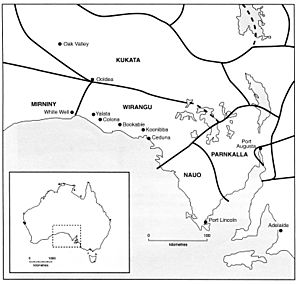Barngarla language facts for kids
Quick facts for kids Barngarla |
|
|---|---|
| Parnkalla | |
| Region | South Australia |
| Ethnicity | Barngarla |
| Extinct | by 1960aiatsis |
| Language family |
Pama–Nyungan
|
| AIATSIS | L6 |

|
|

|
|
Barngarla, also known as Parnkalla, is an Aboriginal language. It comes from the Eyre Peninsula in South Australia. Sadly, the last person who spoke Barngarla as their first language passed away in 1964.
But there's good news! The language is now being brought back to life. This is thanks to a German pastor named Clamor Wilhelm Schurmann. In 1844, he worked at a mission and wrote down 3,500 Barngarla words. This helped create a Barngarla dictionary.
In 2011, a linguist named Ghil'ad Zuckermann, from Adelaide University, reached out to the Barngarla people. He offered to help them bring their language back. The Barngarla community was very excited about this idea. Language workshops started in 2012 in places like Port Lincoln, Whyalla, and Port Augusta. These efforts use the old documents from 170 years ago.
In October 2016, a special mobile app was released. It has a dictionary with over 3,000 Barngarla words. This app helps people learn and use the language.
Contents
How Barngarla is Written
Barngarla is written using an alphabet that has 25 letters. These letters are a mix of single characters and digraphs (two letters that make one sound). They are similar to letters from the English alphabet.
Here are some examples of how Barngarla letters sound:
- a sounds like the "a" in "papa"
- b sounds like a normal English "b"
- g sounds like a normal English "g"
- i sounds like the "i" in "sit"
- l sounds like a normal English "l"
- m sounds like a normal English "m"
- n sounds like a normal English "n"
- w sounds like a normal English "w"
- y sounds like a normal English "y"
Some letter combinations like "ai", "aw", and "ii" are just the sounds of their individual letters put together. For example, "ai" is simply the sound of "a" followed by "i".
When some special sounds come one after another, the letters are written in a shorter way. For example, if you have two "h" sounds together, you only write one "h". This makes the words easier to read and write.
Barngarla Sounds
The stress, or emphasis, in Barngarla words always falls on the first part of the word (the first syllable).
Special Grammar Rules
Counting Things
Barngarla has a unique way of counting things. It uses four different ways to show how many of something there are:
- Singular: For one thing. For example, wárraidya means "emu" (one emu).
- Dual: For two things. For example, wárraidyalbili means "two emus".
- Plural: For a few things. For example, wárraidyarri means "emus" (more than two).
- Superplural: For a lot of things. For example, wárraidyailyarranha means "a lot of emus" or "heaps of emus".
Family Connections
Barngarla also has a special way of talking about family. It shows if a family connection is through the mother's side or the father's side.
For example, the word ngadlaga means "we two". A mother and her child would use this word. A man and his sister's child would also use it. This shows a connection through the mother's family line.
But the word ngarrrinyi also means "we two". A father and his child would use this word. A woman and her brother's child would also use it. This shows a connection through the father's family line.
Naming Children by Birth Order
In traditional Barngarla culture, the order in which children were born was very important. Each child in a family was given a name based on their birth order.
Barngarla has nine different names for boys and nine different names for girls, depending on when they were born:
- Male Names:
- Biri (1st born)
- Warri (2nd born)
- Gooni (3rd born)
- Mooni (4th born)
- Mari (5th born)
- Yari (6th born)
- Mili (7th born)
- Wanggooyoo (8th born)
- Ngalai (9th born)
- Female Names:
- Gardanya (1st born)
- Wayooroo (2nd born)
- Goonda (3rd born)
- Moonaga (4th born)
- Maroogoo (5th born)
- Yaranda (6th born)
- Milaga (7th born)
- Wanggoordoo (8th born)
- Ngalaga (9th born)
To name a new baby, parents would first figure out which number child they were in the family. Then, they would pick the right name based on the baby's gender. For example, if a baby girl was the fourth child born in the family (after three boys), her name would be Moonaga.

